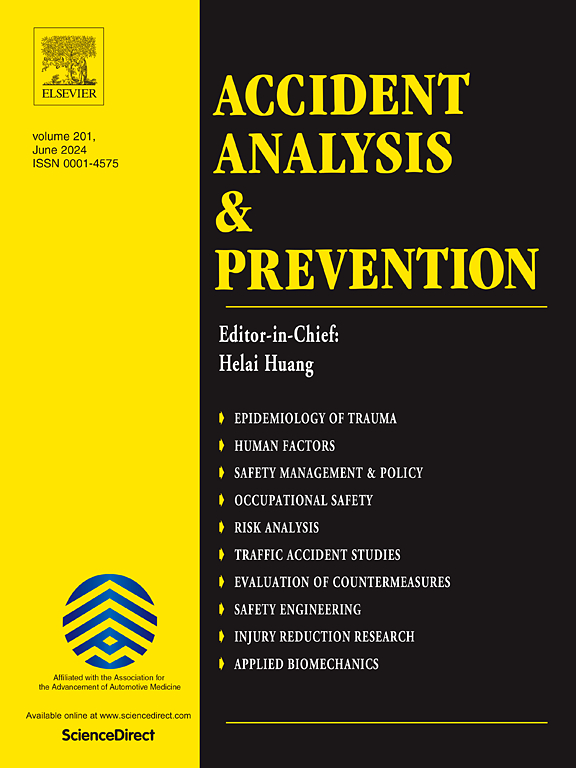Heterogeneous and differential treatment effect analysis of safety improvements on freeways using causal inference
IF 6.2
1区 工程技术
Q1 ERGONOMICS
引用次数: 0
Abstract
Evaluating safety effectiveness of freeway design improvements is crucial for enhancing overall safety and confirming the efficacy of specific measures implemented. Limited research has addressed treatment heterogeneities that influence crash outcomes, and previous studies have often been susceptible to confounding biases, which may distort causal inference results. To mitigate confounding biases and establish reliable causal relationships between crashes and treatment interventions, this study employed a causal forest (CF) model to assess the safety efficacy of freeway exit improvements – including lane control, traffic signs, speed-limit signs, and crash attenuators – on freeways in Suzhou, China. We compared naïve and empirical Bayes before-after methods against the Average Treatment Effect (ATE) estimated by the CF approach. Geometric design and traffic operation characteristics were then considered in measuring the Heterogeneous Treatment Effects (HTE) of these improvements, with the aim of identifying road features where treatment benefits were most pronounced. Additionally, a Differential Treatment Effects (DTE) analysis within a causal framework was employed to estimate treatment effects on the residuals, uncovering more intricate and complex causal relationships. The study demonstrated that CF method provides more stable ATE estimates. An analysis of the distribution of the treatment effects revealed a diverse range of impacts, indicating both positive and negative outcomes. Significant variability in treatment effects was evident from heterogeneous testing results. Noteworthy outcomes from treating freeway exits were observed in areas with an Average Annual Daily Traffic (AADT) ranging from 12,000 to 28,000 vehicles per day, average speeds of 95 km/h and above, two or four lanes on each side, and an exit-only ramp configuration. These findings contribute to valuable technical insights for selecting and evaluating safety enhancement strategies on freeways.
基于因果推理的高速公路安全改进异质性和差异性处理效果分析
评价高速公路设计改进的安全有效性对于提高整体安全性和确认所实施的具体措施的有效性至关重要。有限的研究已经解决了影响碰撞结果的治疗异质性,并且以前的研究经常容易受到混杂偏差的影响,这可能会扭曲因果推断结果。为了减少混杂偏差并建立事故与治疗干预之间可靠的因果关系,本研究采用因果森林(CF)模型来评估中国苏州高速公路出口改进的安全效果,包括车道控制、交通标志、限速标志和碰撞衰减器。我们将naïve和经验贝叶斯前后方法与CF方法估计的平均治疗效果(ATE)进行了比较。然后在测量这些改进的异质处理效果(HTE)时考虑几何设计和交通运行特征,目的是确定处理效果最明显的道路特征。此外,在因果框架内采用差分处理效应(DTE)分析来估计处理对残差的影响,揭示了更复杂的因果关系。研究表明,CF方法提供了更稳定的ATE估计。对治疗效果分布的分析揭示了不同范围的影响,表明了积极和消极的结果。异质性试验结果表明,治疗效果存在显著差异。在平均每日交通量(AADT)为每天12,000至28,000辆,平均速度为95公里/小时及以上,两侧各有2或4条车道,以及仅限出口的匝道配置的地区,观察到处理高速公路出口的显著结果。这些发现为选择和评估高速公路安全增强策略提供了有价值的技术见解。
本文章由计算机程序翻译,如有差异,请以英文原文为准。
求助全文
约1分钟内获得全文
求助全文
来源期刊

Accident; analysis and prevention
Multiple-
CiteScore
11.90
自引率
16.90%
发文量
264
审稿时长
48 days
期刊介绍:
Accident Analysis & Prevention provides wide coverage of the general areas relating to accidental injury and damage, including the pre-injury and immediate post-injury phases. Published papers deal with medical, legal, economic, educational, behavioral, theoretical or empirical aspects of transportation accidents, as well as with accidents at other sites. Selected topics within the scope of the Journal may include: studies of human, environmental and vehicular factors influencing the occurrence, type and severity of accidents and injury; the design, implementation and evaluation of countermeasures; biomechanics of impact and human tolerance limits to injury; modelling and statistical analysis of accident data; policy, planning and decision-making in safety.
 求助内容:
求助内容: 应助结果提醒方式:
应助结果提醒方式:


